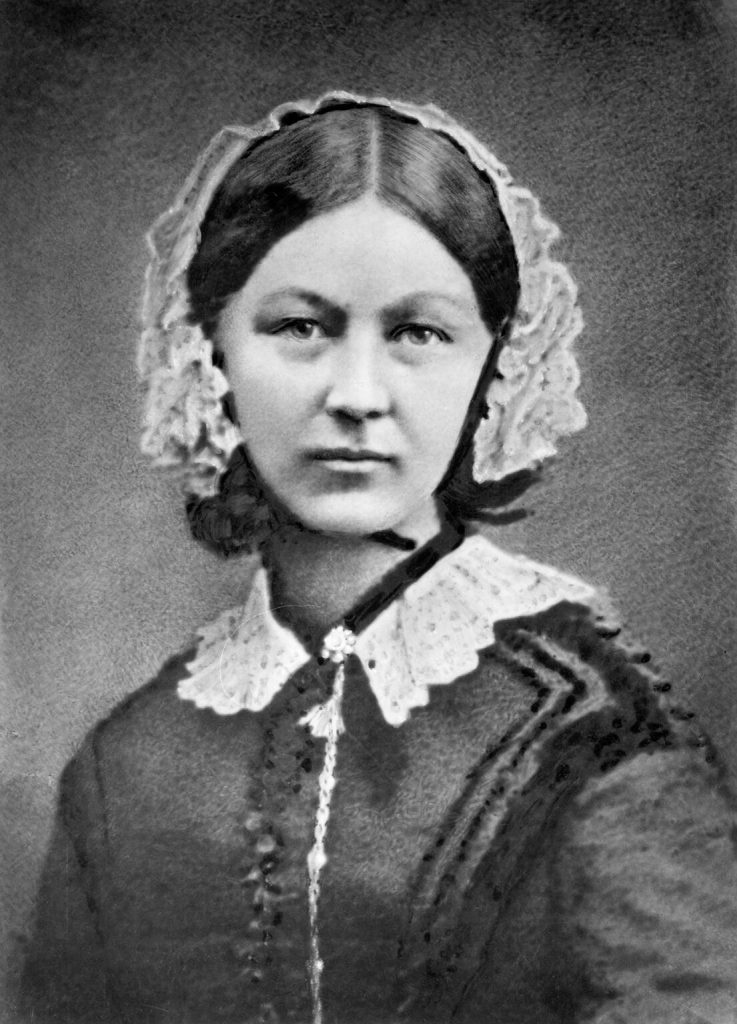1.2 History and Foundation
Brief History of Nursing
Before discussing scope and standards of nursing care, it is helpful to briefly review a history of the nursing profession. Florence Nightingale is considered to be the founder of modern nursing practice. In 1860 she established the first nursing school in the world. By establishing this school of nursing, Nightingale promoted the concept of nurses as a professional, educated workforce of caregivers for the sick.[1] See Figure 1.1[2] for a portrait of Florence Nightingale. Florence Nightingale’s contributions to health care started during the Crimean War in 1854. Her team discovered that poor health care for wounded soldiers was being delivered by overworked medical staff in a dirty environment. Florence recorded the mortality rate in the hospital and created statistical models that demonstrated that out of every 1,000 injured soldiers, 600 were dying because of preventable communicable and infectious diseases. Florence’s nursing interventions were simple; she focused on providing a clean environment, clean water, and good nutrition to promote healing, such as providing fruit as part of the care for the wounded soldiers. With these simple actions, the mortality rate of the soldiers decreased from 60% to 2.2%. In 1859 Nightingale wrote a book titled Notes on Nursing that served as the cornerstone of the Nightingale School of Nursing curriculum. Nightingale believed in the importance of placing a patient in a environment that promoted healing where they could recover from disease. She promoted this knowledge as distinct from medical knowledge. Her emphasis on the value of the environment formed many of the foundational principles that we still use in creating a healing health care setting today. She also insisted on the importance of building trusting relationships with patients and believed in the therapeutic healing that resulted from nurses’ presence with patients. She promoted the concept of confidentiality, stating a nurse “should never answer questions about her sick except to those who have a right to ask them.”[3] These nursing concepts formed the foundation of nursing practice as we know it today.

Modern nursing has reinvented itself a number of times as health care has advanced and changed over the past 160 years. With more than four million members, the nursing profession represents the largest segment of the United States’ health care workforce. Nursing practice covers a broad continuum, including health promotion, disease prevention, coordination of care, and palliative care when cure is not possible. Nurses directly affect patient care and provide the majority of patient assessments, evaluations, and care in hospitals, nursing homes, clinics, schools, workplaces, and ambulatory settings. They are at the front lines in ensuring that patient care is delivered safely, effectively, and compassionately. Additionally, nurses attend to patients and their families in a holistic way that often goes beyond physical health needs and recognize social, mental, emotional, and spiritual needs.[4]
American Nurses Association (ANA)
The American Nurses Association (ANA) is a national, professional nursing organization that was established in 1896. The ANA represents the interests of nurses in all 50 states of America while also promoting improved health care for everyone. The mission of the ANA is to “lead the profession to shape the future of nursing and health care.”[5] The ANA states that it exists to advance the nursing profession by doing the following:
- Fostering high standards of nursing practice
- Promoting a safe and ethical work environment
- Bolstering the health and wellness of nurses
- Advocating on health care issues that affect nurses and the public[6]
The ANA sets many standard of care for professional nurses that will be discussed in the next section.
Read more information about the American Nurses Association
View the Discover the American Nurses Association video.[7]
- Karimi, H., & Masoudi Alavi, N. (2015). Florence Nightingale: The mother of nursing. Nursing and Midwifery Studies, 4(2), e29475. https://www.ncbi.nlm.nih.gov/pmc/articles/PMC4557413/ ↵
- “Florence Nightingale (H Hering NPG x82368).jpg” by Henry Hering (1814-1893) is in the Public Domain ↵
- Karimi, H., & Masoudi Alavi, N. (2015). Florence Nightingale: The mother of nursing. Nursing and Midwifery Studies, 4(2), e29475. https://www.ncbi.nlm.nih.gov/pmc/articles/PMC4557413/. ↵
- Institute of Medicine (US) Committee on the Robert Wood Johnson Foundation Initiative on the Future of Nursing, at the Institute of Medicine. (2011). The future of nursing: Leading change, advancing health. National Academies Press. https://www.ncbi.nlm.nih.gov/books/NBK209880/57413/ ↵
- American Nurses Association. (n.d.). About ANA. https://www.nursingworld.org/ana/about-ana/ ↵
- American Nurses Association. (n.d.). About ANA. https://www.nursingworld.org/ana/about-ana/ ↵
- American Nurses Association. (2010, May 14). Discover the American Nurses Association (ANA). [Video]. YouTube. All rights reserved. https://youtu.be/PRwPhOjeqL4 ↵

